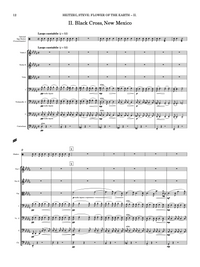Flower of the Earth (Homage to Georgia O’Keefe) – Steve Heitzeg
- Regular
- $19.99
- Sale
- $19.99
- Regular
- Unit Price
- per
If you are interested in a parts set for a performance, please contact us.
Composer: Steve Heitzeg
Instrumentation: 1-2-0-1/2-0-0-0/str
Duration: Approx. 15 minutes
Date Written: 1987
Premiered: Minneapolis Chamber Symphony; Jay Fishman, conductor, Minneapolis, MN on 07/08/1988
Additional Information:
Flower of the Earth (Homage to Georgia O’Keeffe) was composed in celebration of the 100th anniversary of Georgia O’Keeffe’s birth. The work is based on four specific paintings by Georgia O’Keeffe: the four movements symbolically suggest the normal progression of a day from morning to evening, or perhaps, on a grander scale, the stages of life itself.
I. The White Calico Flower, 1931
Georgia O’Keeffe stated, “My first memory is of the brightness of light—light all around.” So, too, the work begins in a very simple and bright manner with the opening pitch of G (for Georgia). Based in C major (all white keys on the piano), this movement slowly begins to unfold (just as the petals of a flower open) and then blossoms into its full and brilliant conclusion. While O’Keeffe’s previous flower paintings had always been based on natural flowers, this painting is based on an artificial flower, most likely made out of calico by some of the Latina or Native American women near where O’Keeffe lived in New Mexico.
II. Black Cross: New Mexico, 1929
O’Keeffe would encounter mysterious wooden crosses, probably erected by secret Catholic lay brotherhoods called Penitentes, on her late-night walks in the desert and wilderness of New Mexico. “I saw the crosses so often—and often in unexpected places—over the New Mexico landscape,” said Georgia O’Keeffe. This black cross with red hills in the distance inspired this elegy for strings.
III. Sky Above Clouds II, 1963
Blue sky and happy clouds: an affirmation of life, the sky and the limitless possibilities of the human spirit. Based on one of O’Keeffe’s paintings from her cloudscapes series from the 1960s and ‘70s, this buoyant and abrupt movement conveys the sudden shifting of clouds, shifting moods of people and the brevity of life itself.
IV. Evening Star III, 1917
This watercolor of O’Keeffe’s is her abstract depiction of the landscape of the American West. This movement is a restful and introspective meditation on the end of the day or, perhaps, the end of a life. A plain and contemplative melody suggests a person’s
child-like or prayer-like wish while looking toward the evening sky.








